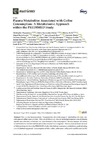Identificador persistente para citar o vincular este elemento:
https://accedacris.ulpgc.es/jspui/handle/10553/69910
| Título: | Plasma metabolites associated with coffee consumption: A metabolomic approach within the PREDIMED study | Autores/as: | Papandreou, Christopher Hernández-Alonso, Pablo Bulló, Mònica Ruiz-Canela, Miguel Yu, Edward Guasch-Ferré, Marta Toledo, Estefanía Dennis, Courtney Deik, Amy Clish, Clary Razquin, Cristina Corella, Dolores Estruch, Ramon Ros, Emilio Fitó, Montserrat Arós, Fernando Fiol, Miquel Lapetra, José Ruano Rodriguez, Cristina Liang, Liming Martínez-González, Miguel A. Hu, Frank B. Salas-Salvadó, Jordi |
Clasificación UNESCO: | 32 Ciencias médicas | Palabras clave: | Caffeine Coffee Metabolomics Plasma Predimed |
Fecha de publicación: | 2019 | Publicación seriada: | Nutrients | Resumen: | Few studies have examined the association of a wide range of metabolites with total and subtypes of coffee consumption. The aim of this study was to investigate associations of plasma metabolites with total, caffeinated, and decaffeinated coffee consumption. We also assessed the ability of metabolites to discriminate between coffee consumption categories. This is a cross-sectional analysis of 1664 participants from the PREDIMED study. Metabolites were semiquantitatively profiled using a multiplatform approach. Consumption of total coffee, caffeinated coffee and decaffeinated coffee was assessed by using a validated food frequency questionnaire. We assessed associations between 387 metabolite levels with total, caffeinated, or decaffeinated coffee consumption (≥50 mL coffee/day) using elastic net regression analysis. Ten-fold cross-validation analyses were used to estimate the discriminative accuracy of metabolites for total and subtypes of coffee. We identified different sets of metabolites associated with total coffee, caffeinated and decaffeinated coffee consumption. These metabolites consisted of lipid species (e.g., sphingomyelin, phosphatidylethanolamine, and phosphatidylcholine) or were derived from glycolysis (alpha-glycerophosphate) and polyphenol metabolism (hippurate). Other metabolites included caffeine, 5-acetylamino-6-amino-3-methyluracil, cotinine, kynurenic acid, glycocholate, lactate, and allantoin. The area under the curve (AUC) was 0.60 (95% CI 0.56-0.64), 0.78 (95% CI 0.75-0.81) and 0.52 (95% CI 0.49-0.55), in the multimetabolite model, for total, caffeinated, and decaffeinated coffee consumption, respectively. Our comprehensive metabolic analysis did not result in a new, reliable potential set of metabolites for coffee consumption. | URI: | https://accedacris.ulpgc.es/handle/10553/69910 | ISSN: | 2072-6643 | DOI: | 10.3390/nu11051032 | Fuente: | Nutrients [ISSN 2072-6643], v. 11 (5), (Mayo 2019) |
| Colección: | Artículos |
Citas SCOPUSTM
21
actualizado el 08-jun-2025
Citas de WEB OF SCIENCETM
Citations
18
actualizado el 08-jun-2025
Visitas
182
actualizado el 17-may-2025
Descargas
226
actualizado el 17-may-2025
Google ScholarTM
Verifica
Altmetric
Comparte
Exporta metadatos
Los elementos en ULPGC accedaCRIS están protegidos por derechos de autor con todos los derechos reservados, a menos que se indique lo contrario.
